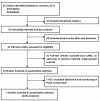Meta-analysis of randomized controlled trials on the efficacy of thoracic epidural anesthesia in preventing atrial fibrillation after coronary artery bypass grafting
- PMID: 22900930
- PMCID: PMC3489521
- DOI: 10.1186/1471-2261-12-67
Meta-analysis of randomized controlled trials on the efficacy of thoracic epidural anesthesia in preventing atrial fibrillation after coronary artery bypass grafting
Abstract
Background: Postoperative atrial fibrillation (POAF) is one of the most common complications in patients undergoing coronary artery bypass grafting (CABG). The goal of this meta-analysis was to evaluate the efficacy of thoracic epidural anesthesia (TEA) in preventing POAF in adult patients undergoing CABG.
Methods: MEDLINE and EMBASE were searched to identify randomized controlled trails in adult patients undergoing CABG who were randomly assigned to receive general anesthesia plus thoracic epidural anesthesia (GA + TEA) or general anesthesia only (GA). Two authors independently extracted data using a standardized Excel file. The primary outcome measure was the incidence of POAF. We used DerSimonian-Laird random-effects models to compute summary risk ratios with 95% confidence intervals.
Results: Five studies involving 540 patients met our inclusion criteria. No significant difference in the incidence of POAF was observed between the two groups (risk ratio, 0.61; 95% confidence interval, 0.33 to 1.12; P = 0.11), with significant heterogeneity among the studies (I2 = 73%, P = 0.005). Sensitivity analyses by primary endpoint, methodological quality and surgical technique yielded similar results.
Conclusions: The limited evidence suggests that TEA shows no beneficial efficacy in preventing POAF in adult patients undergoing CABG. However, the results of this meta-analysis should be interpreted with caution due to significant heterogeneity of the studies included. Thus, the potential infuence of TEA on the incidence of atrial fibrillation following CABG warrants further investigation.
Figures


Similar articles
-
Impact of high thoracic epidural anesthesia on incidence of perioperative atrial fibrillation in off-pump coronary bypass grafting: a prospective randomized study.J Thorac Cardiovasc Surg. 2007 Aug;134(2):460-4. doi: 10.1016/j.jtcvs.2007.03.043. J Thorac Cardiovasc Surg. 2007. PMID: 17662790 Clinical Trial.
-
Intravenous magnesium prevents atrial fibrillation after coronary artery bypass grafting: a meta-analysis of 7 double-blind, placebo-controlled, randomized clinical trials.Trials. 2012 Apr 20;13:41. doi: 10.1186/1745-6215-13-41. Trials. 2012. PMID: 22520937 Free PMC article.
-
Colchicine in Patients With Coronary Disease Who Underwent Coronary Artery Bypass Surgery: A Meta-Analysis of Randomized Controlled Trials.Am J Cardiol. 2024 Nov 15;231:48-54. doi: 10.1016/j.amjcard.2024.09.003. Epub 2024 Sep 5. Am J Cardiol. 2024. PMID: 39243878
-
Prevention of postoperative atrial fibrillation in open heart surgery patients by preoperative supplementation of n-3 polyunsaturated fatty acids: an updated meta-analysis.J Thorac Cardiovasc Surg. 2013 Oct;146(4):906-11. doi: 10.1016/j.jtcvs.2013.03.015. Epub 2013 Apr 12. J Thorac Cardiovasc Surg. 2013. PMID: 23587470 Review.
-
Perioperative risk factors for new-onset postoperative atrial fibrillation after coronary artery bypass grafting: a systematic review.BMC Cardiovasc Disord. 2021 Sep 3;21(1):418. doi: 10.1186/s12872-021-02224-x. BMC Cardiovasc Disord. 2021. PMID: 34479482 Free PMC article.
Cited by
-
Antiarrhythmic Mechanisms of Epidural Blockade After Myocardial Infarction.Circ Res. 2024 Jul 19;135(3):e57-e75. doi: 10.1161/CIRCRESAHA.123.324058. Epub 2024 Jun 28. Circ Res. 2024. PMID: 38939925 Free PMC article.
-
Short-term Effects of High Thoracic Epidural Blockade in Patients With Ischemic Heart Disease and Heart Failure: A Systematic Review and Data Synthesis.Rev Cardiovasc Med. 2025 Jul 31;26(7):37886. doi: 10.31083/RCM37886. eCollection 2025 Jul. Rev Cardiovasc Med. 2025. PMID: 40776935 Free PMC article.
References
-
- Mathew JP, Parks R, Savino JS, Friedman AS, Koch C, Mangano DT, Browner WS. Atrial fibrillation following coronary artery bypass graft surgery: predictors, outcomes, and resource utilization. MultiCenter Study of Perioperative Ischemia Research Group. JAMA. 1996;276:300–306. doi: 10.1001/jama.1996.03540040044031. - DOI - PubMed
-
- Frost L, Mølgaard H, Christiansen EH, Jacobsen CJ, Pilegaard H, Thomsen PE. Atrial ectopic activity and atrial fibrillation/flutter after coronary artery bypass surgery. A case-base study controlling for confounding from age, beta-blocker treatment, and time distance from operation. Int J Cardiol. 1995;50:153–162. doi: 10.1016/0167-5273(95)93684-K. - DOI - PubMed
Publication types
MeSH terms
LinkOut - more resources
Full Text Sources
Medical
Miscellaneous

